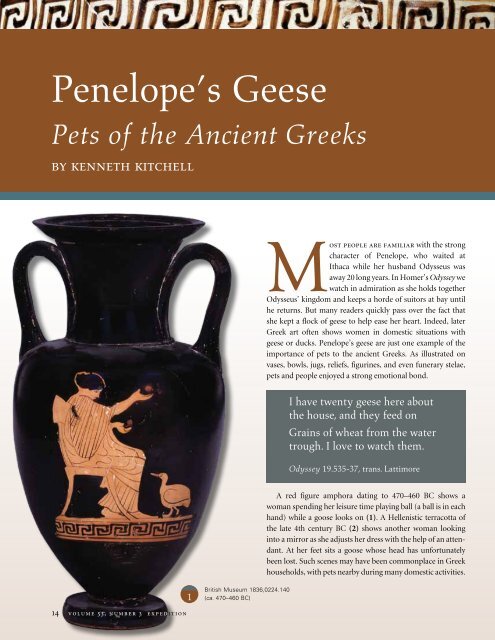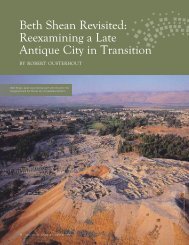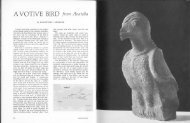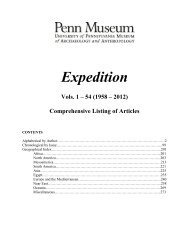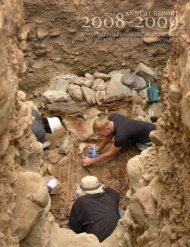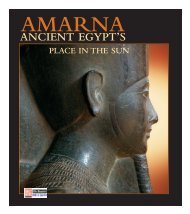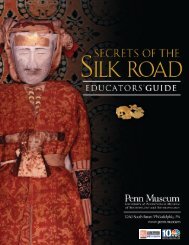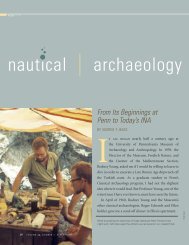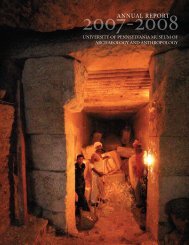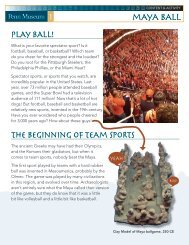Penelope's Geese - University of Pennsylvania Museum of ...
Penelope's Geese - University of Pennsylvania Museum of ...
Penelope's Geese - University of Pennsylvania Museum of ...
You also want an ePaper? Increase the reach of your titles
YUMPU automatically turns print PDFs into web optimized ePapers that Google loves.
Penelope’s <strong>Geese</strong><br />
Pets <strong>of</strong> the Ancient Greeks<br />
by kenneth kitchell<br />
14 volume 53, number 3 expedition<br />
1<br />
British <strong>Museum</strong> 1836,0224.140<br />
(ca. 470–460 BC)<br />
Most people are familiar with the strong<br />
character <strong>of</strong> Penelope, who waited at<br />
Ithaca while her husband Odysseus was<br />
away 20 long years. In Homer’s Odyssey we<br />
watch in admiration as she holds together<br />
Odysseus’ kingdom and keeps a horde <strong>of</strong> suitors at bay until<br />
he returns. But many readers quickly pass over the fact that<br />
she kept a flock <strong>of</strong> geese to help ease her heart. Indeed, later<br />
Greek art <strong>of</strong>ten shows women in domestic situations with<br />
geese or ducks. Penelope’s geese are just one example <strong>of</strong> the<br />
importance <strong>of</strong> pets to the ancient Greeks. As illustrated on<br />
vases, bowls, jugs, reliefs, figurines, and even funerary stelae,<br />
pets and people enjoyed a strong emotional bond.<br />
I have twenty geese here about<br />
the house, and they feed on<br />
Grains <strong>of</strong> wheat from the water<br />
trough. I love to watch them.<br />
Odyssey 19.535-37, trans. Lattimore<br />
A red figure amphora dating to 470–460 BC shows a<br />
woman spending her leisure time playing ball (a ball is in each<br />
hand) while a goose looks on (1). A Hellenistic terracotta <strong>of</strong><br />
the late 4th century BC (2) shows another woman looking<br />
into a mirror as she adjusts her dress with the help <strong>of</strong> an attendant.<br />
At her feet sits a goose whose head has unfortunately<br />
been lost. Such scenes may have been commonplace in Greek<br />
households, with pets nearby during many domestic activities.
Trustees <strong>of</strong> the British <strong>Museum</strong><br />
Another pet in the Odyssey is justifiably famous—<br />
Odysseus’ long-suffering dog. As Odysseus nears his<br />
home in a deformed beggar’s disguise provided by Athena,<br />
he has fooled everyone he has met. But at the city gates<br />
lies an old dog named Argos. Odysseus had raised him<br />
but left for Troy before the dog was fully grown.<br />
Argos had been a great hunter in his day, but now he is<br />
banished outside the gates <strong>of</strong> Ithaca, lying “in the dung,<br />
all covered with dog ticks” (Od. 17.300, trans. Lattimore),<br />
no longer useful to those who are making decisions in<br />
Odysseus’ absence. He is at least 20 years old—ancient in<br />
dog years—but as soon as Odysseus comes near, he sees<br />
through the disguise and recognizes his master. In one <strong>of</strong><br />
the most heart-wrenching scenes from antiquity, the dog—<br />
who can no longer walk—lays his ears back, wags his tail,<br />
and closes his eyes for the last time. Homer tells us that<br />
tears came to Odysseus’ eyes as he watched the dog first<br />
welcome him and then die.<br />
Our first instinct is to view both scenes through modern<br />
eyes and think <strong>of</strong> the geese and Argos as family pets. But we<br />
must proceed carefully. Odysseus, pretending he does not<br />
know Argos, asks his guide whether the dog was a hunter<br />
in his day or perhaps “one <strong>of</strong> the kind <strong>of</strong> table dog that<br />
gentlemen keep, and it is only for show that their masters<br />
care for them” (Od. 17.309-10, trans. Lattimore). Herein<br />
lies the crux <strong>of</strong> the problem, because before we talk about<br />
the pets <strong>of</strong> the Greeks, we would be wise to define what a<br />
pet actually is. A pet is generally defined as an animal kept<br />
for companionship or amusement. But what about companion<br />
animals that also serve a practical use such as hunting<br />
or guarding, as Argos did? One would also assume<br />
that humans do not eat their pets. But did Penelope ever<br />
eat her geese? If they were kept for their flesh or eggs, an<br />
argument can be made that they were farm animals as well<br />
as pets. It is clear, then, that while some animals were kept<br />
strictly for emotional reasons, other pets might serve multiple<br />
functions.<br />
common pets<br />
Dogs<br />
Dogs were domesticated early and soon became close<br />
companions to humans. Current evidence suggests that<br />
dogs were domesticated by ca. 13,000 BC. Cats, on the<br />
other hand, are thought to have been domesticated later,<br />
about 8,000 BC in the Near East, not Egypt as is commonly<br />
2<br />
3<br />
British <strong>Museum</strong> 1982,0729.83<br />
(late 4th century BC)<br />
British <strong>Museum</strong> 1876,0328.2 (attributed to the Thanatos painter,<br />
435–425 BC)<br />
www.penn.museum/expedition 15
4<br />
5<br />
British <strong>Museum</strong> 1867,0506.38 (attributed to Amasis<br />
painter, 550–530 BC)<br />
British <strong>Museum</strong> 1843,1103.88 (attributed to Dikaios<br />
painter, 510–500 BC)<br />
16 volume 53, number 3 expedition<br />
7<br />
thought. Sometimes evidence <strong>of</strong> human-animal bonds<br />
appears in the archaeological record; a late Paleolithic<br />
burial in northern Israel dating from about 12,000 years<br />
ago yielded the skeleton <strong>of</strong> an elderly person <strong>of</strong> uncertain<br />
gender who had a hand placed carefully over the skeleton<br />
<strong>of</strong> a puppy.<br />
Mycenaean art frequently includes dogs, and the burial<br />
<strong>of</strong> dogs with humans is a well-known Mycenaean custom.<br />
The Ashmolean <strong>Museum</strong> at the <strong>University</strong> <strong>of</strong> Oxford<br />
exhibits a Mycenaean rhyton (drinking vessel), dated<br />
1300–1190 BC, in the shape <strong>of</strong> dog or fox head. By classical<br />
Greek times the breeding <strong>of</strong> dogs had flourished, and<br />
D.B. Hull in his Hounds and Hunting in Ancient Greece<br />
(1964) patiently collected the names <strong>of</strong> at least 29 separate<br />
breeds, not counting breeds that may have been imported.<br />
The ancients mention the Castrian, Molossian, Cretan,<br />
Laconian, “fox-dog,” and many more, each with specific<br />
traits that made them appealing to humans. Equating these<br />
descriptions to modern breeds is difficult, if not impossible,<br />
but it is safe to say that Greek dogs fell into three basic<br />
categories. The first was a large mastiff-type dog such as the<br />
Molossian hound whose job was to guard flocks and fend<br />
<strong>of</strong>f wolves. These animals probably spent the majority <strong>of</strong><br />
their time outside and may not have been considered pets.<br />
The second type was used for hunting and was bred for<br />
speed, tracking, and tenacity (3). These dogs—the most<br />
British <strong>Museum</strong> 1848,1020.97 (Nereid Monument, Lycia,<br />
390–380 BC)
Trustees <strong>of</strong> the British <strong>Museum</strong><br />
common were Laconian (Spartan) and Cretan—straddle<br />
the line between pet and work animal, for we <strong>of</strong>ten see<br />
them on Greek vases, accompanying young aristocrats on<br />
the hunt for deer, hare, and boar (4). They are also shown<br />
frequently in scenes depicting soldiers departing for war,<br />
perhaps indicating the close ties between men and dogs.<br />
One such scene (5) is <strong>of</strong> interest for many reasons (Why<br />
is a Phrygian archer here? Why does the old man hold<br />
his nose?), but is especially interesting because it clearly<br />
shows a dog’s body language. The dog appears nervous<br />
or anxious, a state brought on, we are to understand, by<br />
the imminent departure <strong>of</strong> its master. Such dogs were<br />
the constant companions <strong>of</strong> young aristocrats (in some<br />
periods described as ephebes), <strong>of</strong>ten in public places such<br />
as the gymnasium. When these young men are courted<br />
by older men—a common social interaction in ancient<br />
Athens—“love gifts,” many caught with the help <strong>of</strong> dogs,<br />
are <strong>of</strong>ten exchanged. A black figure amphora shows these<br />
gifts (6): a deer to the left, a hare hanging on the wall, and<br />
a fox to the right. The dogs <strong>of</strong> young aristocrats commonly<br />
wear collars, are <strong>of</strong>ten on leashes, and frequently recline<br />
under the young men’s couches at symposia, Greek drinking/dinner<br />
parties. So popular was this custom that the<br />
sculptor <strong>of</strong> the Nereid Monument from Lycia even shows<br />
King Arbinas with his dog (7). The writer Xenophon, best<br />
known for his histories and his works on Socrates, even<br />
6<br />
8<br />
British <strong>Museum</strong> 1865,1118.39 (attributed<br />
to Berlin painter, ca. 540 BC)<br />
British <strong>Museum</strong> 1864,1007.231 (ca. 420–400 BC)<br />
www.penn.museum/expedition 17
9<br />
10<br />
British <strong>Museum</strong> 1928,0117.61 (420–400 BC)<br />
British <strong>Museum</strong> 1843,1103.74 (attributed to Berlin<br />
painter, ca. 480 BC)<br />
18 volume 53, number 3 expedition<br />
wrote a treatise called the Kynegitika on the breeding,<br />
rearing, and training <strong>of</strong> just this sort <strong>of</strong> dog.<br />
The third type <strong>of</strong> dog is as much a creature <strong>of</strong> the<br />
house as the Molossian was <strong>of</strong> the field. These little<br />
Maltese definitely fall into the realm <strong>of</strong> “pet” for they<br />
serve no practical purpose other than to provide pleasure<br />
and companionship to their owners. In ancient Athens,<br />
a three-day festival to Dionysus took place each year<br />
called the Anthesteria, which was characterized by great<br />
merriment and drinking. During the festival children<br />
were given miniature versions <strong>of</strong> vases called choes (singular<br />
chous) which <strong>of</strong>ten depicted boys or girls with<br />
Maltese dogs. It has been persuasively suggested that<br />
children received pets as gifts at the Anthesteria; it is possible<br />
that male children were given Maltese dogs when<br />
young and then, in a kind <strong>of</strong> rite <strong>of</strong> passage, graduated<br />
up to a hunting dog, which then accompanied them on<br />
the hunt and on social occasions. Other animals are also<br />
seen on these choes, many <strong>of</strong> which are undoubtedly<br />
pets. A chous from the British <strong>Museum</strong> shows a young<br />
boy with two pets: a Maltese and a bird that may represent<br />
a jackdaw or a song bird (8). Another charming<br />
chous in the British <strong>Museum</strong> shows a young boy holding<br />
a bird and a push toy, perhaps another gift (9). Other<br />
choes bear images <strong>of</strong> roosters, birds that may be ducks or<br />
geese, hares, and carts drawn by (pet?) goats and fawns.<br />
Roosters, in fact, were commonly kept by aristocratic<br />
youths for the purpose <strong>of</strong> cock fighting (10). A<br />
chous in the Fitzwilliam <strong>Museum</strong><br />
showing a large water bird pulling<br />
a cart may be more fanciful<br />
than factual.<br />
Although the Maltese is mostly associated<br />
with children and women, it is occasionally<br />
shown with an adult male. A famous<br />
vase (11) shows a wreathed reveler on his way home<br />
from a symposium, singing and playing the lyre, and<br />
accompanied by his small pet. Some scholars have even<br />
suggested that the figure is Anakreon, a famous 6th century<br />
BC lyric poet.<br />
Cats<br />
The question <strong>of</strong> the cat as a pet in ancient Greece is<br />
rather vexing. Modern Athens is home to countless feral<br />
cats. However, the status <strong>of</strong> the cat in ancient Greece<br />
is unclear, as images <strong>of</strong> cats are fairly rare. The Greeks<br />
Trustees <strong>of</strong> the British <strong>Museum</strong>
Penn <strong>Museum</strong> (top), National Archaeological <strong>Museum</strong> Athens, Hellenic Ministry <strong>of</strong> Culture and Tourism/Archaeological Receipts Fund (bottom)<br />
undoubtedly learned <strong>of</strong> the cat through contact with<br />
Egypt where the cat was so beloved that, according to the<br />
historian Herodotus, Egyptians shaved <strong>of</strong>f their eyebrows<br />
when a pet cat died. But the Greeks seem never to have<br />
formed the same depth <strong>of</strong> attachment to the cat, and references<br />
to them are so infrequent in the literature that<br />
most scholars think their presence in ancient Greece was<br />
minimal. Cats were probably kept by Greek households<br />
as liminal animals—animals that come and go from the<br />
house as they wish. This may account for the fact that<br />
few cat bones have been found in domestic situations.<br />
In Greece the important job <strong>of</strong> “mouser” seems to have<br />
been handled by weasels and ferrets, many <strong>of</strong> which<br />
were also considered liminal pets. Yet some clear representations<br />
<strong>of</strong> cats do exist. The National Archaeological<br />
<strong>Museum</strong> <strong>of</strong> Athens hosts a famous funerary kouros base<br />
(NAM #3476) dating to about 510 BC that shows two<br />
seated Athenian noble youths, each holding a pet on a<br />
leash, one a cat, the other a dog. Other sides <strong>of</strong> the base<br />
show young men exercising in the gymnasium, and we<br />
are left to imagine that each <strong>of</strong> the seated youths has<br />
come to the gymnasium to show <strong>of</strong>f his pet. The arched<br />
back <strong>of</strong> a cat as it faces a dog is familiar to anyone who has<br />
ever seen such an encounter. A funeral stele from Aegina<br />
or Salamis dates to 430–420 BC, and with craftsmanship<br />
<strong>of</strong> the highest order, it shows a youth in pr<strong>of</strong>ile, holding<br />
a bird in his left hand and extending his right hand<br />
toward a cage (12). Just below the cage is a rectangular<br />
pillar, and upon this sits an animal, which—although his<br />
head is missing—is almost assuredly a domestic cat. An<br />
unusual askos in the shape <strong>of</strong> a lobster’s claw (13) shows<br />
a rather poorly drawn cat. One might take it for a wild<br />
cat, but elsewhere on the vessel are a dog and a cock, both<br />
<strong>of</strong> which were likely pets.<br />
Birds<br />
In addition to the geese described earlier, many birds<br />
were kept as pets. Next to dogs, they may have been the<br />
second most common type <strong>of</strong> pet in ancient Greece. The<br />
name vase <strong>of</strong> the Cage Painter (14) clearly shows a bird<br />
in a cage being held on a young man’s lap. Was this a<br />
personal pet or intended as a gift?<br />
As noted earlier, young children were given birds as<br />
pets. Grave stelae <strong>of</strong> children regularly show them holding<br />
a bird, commonly a dove. Many stelae, such as the<br />
Melisto stele in the Harvard Sackler <strong>Museum</strong> (15), show<br />
11<br />
12<br />
Penn <strong>Museum</strong> 75-10-1 (450–440 BC)<br />
National Archaeological <strong>Museum</strong>, Athens, stele #715<br />
www.penn.museum/expedition 19
13<br />
14<br />
15<br />
British <strong>Museum</strong> 1905,0710.9 (ca. 470–400 BC)<br />
British <strong>Museum</strong> 1901,0514.1 (name vase <strong>of</strong> Cage<br />
painter, 485–480 BC)<br />
Harvard Sackler <strong>Museum</strong> 1961.86<br />
20 volume 53, number 3 expedition<br />
a deceased child holding out a bird to a Maltese dog,<br />
as if inviting play. Pet birds are also depicted in happier<br />
circumstances. Plutarch and other authors tell us<br />
that starlings, crows, and parrots were all kept as pets<br />
and that these birds delighted their owners by imitating<br />
their voices. Likewise, small songbirds such as sparrows<br />
were kept in cages to entertain their owners with their<br />
song. Several Greek vases even show long-legged birds<br />
such as cranes in the women’s quarters, and the famous<br />
Alcibiades had a pet quail.<br />
less common pets<br />
Over 30 years ago, Ann Ashmead published “Greek<br />
Cats” in this magazine (Expedition 20[3]:38-47). She<br />
was inspired by a vase in the Penn <strong>Museum</strong> (16) which<br />
effectively demonstrated that cheetahs were kept by aristocratic<br />
youths. The cheetahs may have been purchased<br />
from Egypt where they were also kept as pets. Cheetahs<br />
on Greek vases are clearly status symbols and <strong>of</strong>ten have<br />
collars and leashes (17).<br />
A red figure hydria (18) dating to the end <strong>of</strong> the<br />
Persian Wars (middle <strong>of</strong> the 5th century BC) shows a<br />
music lesson to which the students have brought their<br />
pets. The Maltese dog beneath the chair is <strong>of</strong> interest, but<br />
one youth, clearly showing <strong>of</strong>f his affluence, is leading<br />
a cheetah on a leash. The relative size <strong>of</strong> the cat compared<br />
to the small dog leads us to believe it is still young.<br />
Compare this to the music lesson scene on the shoulder<br />
<strong>of</strong> a hydria attributed to the Agrigento painter and dating<br />
about ten years after the previous vase (19). Here a young<br />
cheetah is on a low table, to be admired by one and all.<br />
To the right side <strong>of</strong> the scene a figure is seated on the<br />
ground, leaning on its left side. The features <strong>of</strong> the figure<br />
lead us to believe that this may also be a pet—a monkey<br />
or small ape. Although there is scant evidence for simian<br />
pets in this period, we know that monkeys and apes were<br />
very popular as pets in later antiquity.<br />
A visit to an ancient Greek house might reveal a wide<br />
variety <strong>of</strong> other less traditional pets as well. Grasshoppers,<br />
crickets, and cicadas (20) were kept in tiny cages and<br />
were valued for their song. The Greek Anthology even<br />
has some epitaphs expressly written for such pets upon<br />
their demise, and the poet Meleager laments the loss <strong>of</strong><br />
his cicada after three years <strong>of</strong> captivity, claiming that<br />
its singing helped him sleep and drove away cares. An<br />
ancient commentator on a passage from Aristophanes’<br />
Trustees <strong>of</strong> the British <strong>Museum</strong> (top and center), Harvard Art <strong>Museum</strong>s/Arthur M. Sackler <strong>Museum</strong> (bottom)
Penn <strong>Museum</strong> (top left), Trustees <strong>of</strong> the British <strong>Museum</strong> (remainder <strong>of</strong> page)<br />
16 Penn <strong>Museum</strong> MS 399 (480 BC)<br />
17<br />
18 19<br />
British <strong>Museum</strong> 1864,1007.85 (attributed to Pig painter,<br />
480–470 BC)<br />
British <strong>Museum</strong> 1836, 0224.230 (attributed to<br />
Apollodoros painter, ca. 490 BC)<br />
British <strong>Museum</strong> 1864,1007.84 (attributed to Agrigento<br />
painter, 470–460 BC)<br />
www.penn.museum/expedition 21
20<br />
21<br />
22<br />
British <strong>Museum</strong>, sard scarab 1814,0704.1291<br />
(5th century BC)<br />
British <strong>Museum</strong> 1892,0718.7 (510–500 BC)<br />
Worcester Art <strong>Museum</strong><br />
22 volume 53, number 3 expedition<br />
Wasps tells us that children would tie a thread to the leg <strong>of</strong><br />
a beetle and let them buzz through the air. They may have<br />
been pets or simply played with and released.<br />
Let us end this section with two animals generally overlooked<br />
as pets for the Greeks. The first is the hare. We<br />
have seen above that the hare was routinely hunted and<br />
presented as a gift. The hare’s fertility and active sex life<br />
associate it with Aphrodite and Eros. But evidence exists<br />
that the hare was also kept as a pet and not merely presented<br />
as a lifeless, tasty morsel to be eaten. A red-figured<br />
cup shows a youth running with a hare (21). A Tanagra<br />
figurine shows a girl holding a hare, and the Worcester Art<br />
<strong>Museum</strong> has a fine pyxis which shows Erotes at play, with<br />
a hare on a leash (22).<br />
Our last uncommon pet is the hedgehog, which was<br />
kept in and around houses, no doubt for its tendency<br />
to eat slugs and snails. Aristotle reported that a man in<br />
Byzantium kept a hedgehog that earned him a living by<br />
forecasting the weather. Hedgehogs build burrows with<br />
two entrances and, so it was told, blocked <strong>of</strong>f one <strong>of</strong> them<br />
if bad weather was on the way.<br />
the treatment <strong>of</strong> animals<br />
The number <strong>of</strong> pets appearing with humans on grave stelae,<br />
vases, and other objects is testimony to the fact that many<br />
Greeks formed strong emotional attachments to their pets.<br />
But were the Greeks enlightened as to animal “rights”?<br />
And do we know what their attitude was toward animal<br />
cruelty? Although the answers to these questions are not<br />
known with certainty, at least we can point to the relative<br />
infrequency with which tales <strong>of</strong> animal abuse appear in the<br />
Greek world, as well as the reverse—strong cases indicating<br />
respect for pets. Alcibiades, Socrates’ student and the<br />
most famous playboy <strong>of</strong> late 5th century BC Athens, once<br />
paid 70 minae for a dog. A mna (or mina) was worth 100<br />
drachmas, so he paid 7,000 drachmas for the dog. This was<br />
a considerable sum, as a skilled laborer at that time earned<br />
only about one drachma a day. Plutarch, in writing about<br />
the life <strong>of</strong> Alcibiades, tells us that he had the dog’s tail cut<br />
<strong>of</strong>f, which caused great resentment among his friends who<br />
said: All <strong>of</strong> Athens felt sorry for the dog.<br />
This writer knows <strong>of</strong> only one vase which depicts<br />
animal mistreatment. A late chous (360–350 BC) in the<br />
British <strong>Museum</strong> shows a young girl whirling a turtle about<br />
by a string attached to its rear foot, teasing her pet Maltese<br />
dog in the process (23). This may be compared to depic-<br />
Trustees <strong>of</strong> the British <strong>Museum</strong> (top and center), Worcester Art <strong>Museum</strong> (bottom)
Trustees <strong>of</strong> the British <strong>Museum</strong><br />
tions on funeral stelae <strong>of</strong> children holding birds in the air<br />
over leaping Maltese dogs, although these may be construed<br />
as scenes <strong>of</strong> play.<br />
One last anecdote sums up the attachment between<br />
the ancient Greeks and their pets. The date was 480 BC,<br />
and the Persians under Xerxes were closing in on Athens,<br />
which they would soon sack and burn. Themistocles<br />
ordered the evacuation <strong>of</strong> women, children, and the<br />
elderly. Among these was Xanthippus, the father <strong>of</strong><br />
Pericles. Plutarch, in his life <strong>of</strong> Themistocles, relates that<br />
the dogs <strong>of</strong> Athens ran about howling at being separated<br />
from their masters, but the dog <strong>of</strong> Xanthippus swam after<br />
his master’s ship all the way to Salamis. He emerged from<br />
the water and promptly died <strong>of</strong> exhaustion on the shore.<br />
Showing his affection for his dedicated pet, Xanthippus<br />
buried the dog in a place near the sea that is known even<br />
today as the Dog’s Tomb. This brings us full circle, back<br />
to the emotion shown by Odysseus for Argos. The ancient<br />
Greeks kept a variety <strong>of</strong> animals for reasons other than<br />
utility. They also kept them for the emotional gratification<br />
they <strong>of</strong>fered their owners.<br />
kenneth kitchell is a Pr<strong>of</strong>essor in the Department <strong>of</strong><br />
Classics at the <strong>University</strong> <strong>of</strong> Massachusetts Amherst.<br />
For Further Reading<br />
Arnott, W. Ge<strong>of</strong>frey. Birds in the Ancient World from A to Z.<br />
London: Routledge, 2007.<br />
Beavis, Ian C. Insects and Other Invertebrates in Classical<br />
Antiquity. Exeter: <strong>University</strong> <strong>of</strong> Exeter, 1988.<br />
Brewer, Douglas, Terence Clark, and Adrian Phillips. Dogs in<br />
Antiquity: Anubis to Cerberus. The Origins <strong>of</strong> the Domestic<br />
Dog. Warminster: Aris & Phillips, 2001.<br />
Davies, Malcolm, and Jeyaraney Kathirithamby. Greek<br />
Insects. London: Duckworth, 1986.<br />
Douglas, Norman. Birds and Beasts <strong>of</strong> the Greek Anthology.<br />
New York: Cape and Smith, 1929.<br />
Engels, Donald. Classical Cats: The Rise and Fall <strong>of</strong> the Sacred<br />
Cat. London: Routledge, 1999.<br />
Hull, Denison B. Hounds and Hunting in Ancient Greece.<br />
Chicago, <strong>University</strong> <strong>of</strong> Chicago Press, 1964.<br />
Kitchell, Kenneth. Animals in the Ancient World from A-Z.<br />
Routledge, 2013 (forthcoming).<br />
Pollard, John. Birds in Greek Life and Myth. London: Thames<br />
and Hudson, 1977.<br />
23<br />
British <strong>Museum</strong> 1856,0512.12 (360–350 BC)<br />
www.penn.museum/expedition 23


